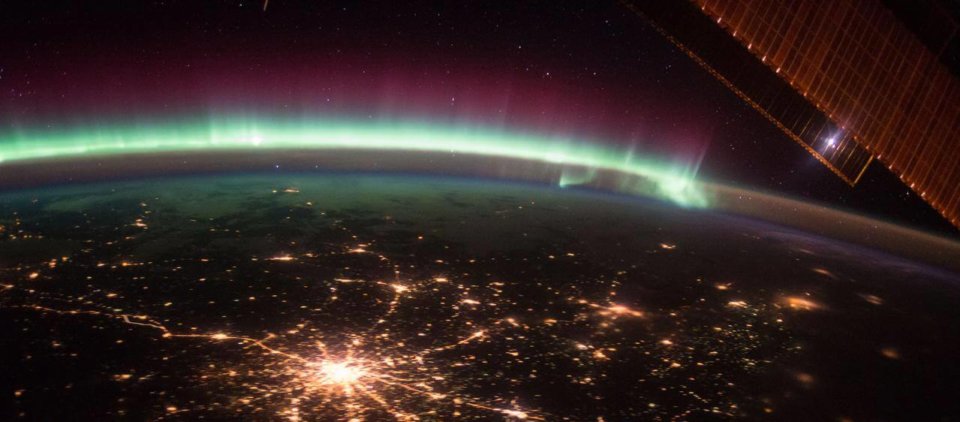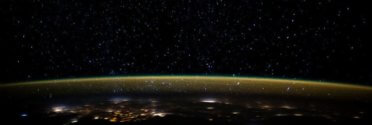This is the Saint Louis Science Center’s NIGHT SKY UPDATE for the week of Friday, April 24, 2020.
Information updated weekly or as needed.
Times given as local St. Louis time (CDT). For definitions of terminology used in the night sky update, click the highlighted text.
For now, star parties at the Saint Louis Science Center have been canceled due to recommendations from the CDC regarding COVID-19. All public telescope events are canceled until further notice. As conditions change, we will reevaluate and update this article once public observing events resume.
The Sun and Moon

The Moon as seen from the International Space Station, on July 31, 2011.
Credit: NASA
Sunrise is at 6:12 a.m. on Friday, April 24 and sunset is at 7:47 p.m. providing us with about 13.5 hours of daylight. Even after sunset, the light from the Sun will dimly illuminate our sky for almost 2 hours. This period is called twilight, which ends around 9:36 p.m. this week. For those with a sundial, solar transit or local noon occurs around 12:58 p.m. this week.
| Day | Sunrise | Sunset |
|---|---|---|
| 2020-04-24 | 6:12 a.m. | 7:47 p.m. |
| 2020-04-25 | 6:11 a.m. | 7:48 p.m. |
| 2020-04-26 | 6:09 a.m. | 7:49 p.m. |
| 2020-04-27 | 6:08 a.m. | 7:50 p.m. |
| 2020-04-28 | 6:07 a.m. | 7:51 p.m. |
| 2020-04-29 | 6:06 a.m. | 7:52 p.m. |
| 2020-04-30 | 6:04 a.m. | 7:53 p.m. |
| 2020-05-01 | 6:03 a.m. | 7:54 p.m. |
| 2020-05-02 | 6:02 a.m. | 7:55 p.m. |
Moonrise for Friday, April 24 occurs at 7:17 a.m. and moonset will occur at 9:26 p.m. On Friday, April 24 the Moon will be exhibiting a waxing crescent phase with roughly 3% of the lunar disk illuminated. First quarter moon occurs on April 30.
International Space Station (ISS) Observing

Visible passes of ISS from St. Louis for the week of April 24 occur during morning hours. The best of these occur on the mornings of April 26, 28 and 29. Use the table below for information about these and other visible passes of ISS.
| Date | Starts | Max. altitude | Ends | |||||||
|---|---|---|---|---|---|---|---|---|---|---|
| Time | Alt. | Az. | Time | Alt. | Az. | Time | Alt. | Az. | ||
| 24 Apr | -1.4 | 05:15:20 | 10 | S | 05:17:46 | 19 | SE | 05:20:11 | 10 | E |
| 26 Apr | -3.4 | 05:15:56 | 13 | SW | 05:18:47 | 59 | SE | 05:22:07 | 10 | ENE |
| 27 Apr | -2.5 | 04:30:12 | 27 | SSE | 04:31:06 | 32 | SE | 04:34:09 | 10 | ENE |
| 28 Apr | -1.3 | 03:44:22 | 16 | ESE | 03:44:22 | 16 | ESE | 03:45:51 | 10 | E |
| 28 Apr | -3.1 | 05:17:19 | 14 | WSW | 05:20:00 | 44 | NW | 05:23:16 | 10 | NE |
| 29 Apr | -3.8 | 04:31:24 | 49 | WSW | 04:32:10 | 78 | NW | 04:35:33 | 10 | NE |
| 30 Apr | -2.4 | 03:45:25 | 38 | ENE | 03:45:25 | 38 | ENE | 03:47:43 | 10 | ENE |
| 30 Apr | -1.8 | 05:18:47 | 10 | WNW | 05:21:25 | 20 | NNW | 05:24:02 | 10 | NNE |
| 01 May | -2.3 | 04:32:17 | 23 | WNW | 04:33:26 | 29 | NNW | 04:36:27 | 10 | NNE |
| 02 May | -2.6 | 03:46:10 | 39 | N | 03:46:10 | 39 | N | 03:48:47 | 10 | NE |
Magnitude (Mag): The Measure of brightness for a celestial object. The lower the value is, the brighter the object will be.
Altitude (Alt): The angle of a celestial object measured upwards from the observer’s horizon.
Azimuth (Az): The direction of a celestial object, measured clockwise from an observer’s location with north being 0°, east being 90°, south being 180° and west being 270°.
For information about ISS flyovers and other visible satellites, visit www.heavens-above.com
Detailed information regarding all unmanned exploration of our universe, missions past, present, and planned, can be found at Jet Propulsion Laboratories:
The Visible Planets

Looking West, 30 Minutes After Sunset, April 24, 2020
Credit: Stellarium, EG

Looking Southeast, 4:00 am, April 25, 2020
Credit: Stellarium, EG
This week, four naked eye planets are visible. Venus will be visible in the west just after sunset. Mars, Jupiter and Saturn are visible in the southeast about 2 hours before sunrise.
Venus
The brightest planet in the sky is visible in the western sky as the sun sets. Venus reached maximum elongation for its current apparition; because of this Venus will start to move towards the Sun each night as it approaches inferior conjunction on June 3, 2020. Venus will set around 11:21 p.m.
Mars
The red planet rises around 3:06 a.m. and will be high enough to see in the southeast by 4:00 a.m. Opposition for Mars occurs on October 13, 2020. As we head towards this date Mars will appear brighter and its surface will eventually be visible through a telescope.
Jupiter
The king of the planets is rising around 1:55 a.m. and should be visible in the southeast around 3:00 a.m. Each week you will find Jupiter rising about 30 minutes earlier than it did in the previous week.
Saturn
Saturn is rising around 2:12 a.m. Like Jupiter you will need a clear sky to the southeast to catch the ring planet around 3:30 a.m. Later this year Jupiter and Saturn will reach conjunction on December 21, 2020. You can track these planets as they appear to chase one another throughout the rest of this year.
2020 Great Conjunction
This year, the planets Jupiter and Saturn will reach conjunction. A conjunction is when two or more celestial bodies share the same right ascension. For Jupiter and Saturn, this astronomical event only occurs every 20 years. The conjunction will occur on December 21, 2020. You will find the two planets close together in the southwestern sky just after sunset on this date.
Comet Watch

UPDATE for C/2019 Y4 ATLAS April 24, 2020
Comet C/2019 Y4 ATLAS continues to hang at about at 9.5 magnitude. In early April astronomers noted a distinct change in the comet’s appearance. Initially C/2019 Y4 ATLAS’s core looked more compact until April when it has changed to a more elongated fuzzy appearance. This suggested the comet has fragmented. Continued observation of this comet has confirmed it is fragmenting. This does not mean the comet will not reach naked eye visibility, but it does not look good. With the continued fade it appears this comet will under perform. It is still worth tracking it as it approaches its flyby of the Earth on May 23.
In dark skies C/2019 Y4 ATLAS is still within reach of backyard telescopes 6 inches and larger, however, in the city lights of St. Louis it will be very difficult to see. Current attempts to locate the comet by this author have been unsuccessful due to light pollution. As we head towards Comet C/2019 Y4 ATLAS’s closest approach to Earth on May 23, 2020, we will continue to update the current magnitude of this comet in the night sky update.
Comet SWAN (C/2020 F8)
With what seems to be another comet let down, there is hope for comet hunters. A comet was recently discovered by Michael Mattiazzo searching imagery from the Solar Wind Anisotropies (SWAN) camera on the Solar and Heliospheric Observatory (SOHO). SWAN’s primary science objective has to do with monitoring the solar wind in Lyman-α light, a type of UV radiation. It also monitors sunspots and can observe comets in this same emitted wavelength of light. Learn more at https://sohowww.nascom.nasa.gov/about/instruments.html
Right now, Comet SWAN is in the constellation Sculptor and is rising around the same time as the Sun. Comet Swan will be visible in the northern hemisphere near the end of April. Currently Comet SWAN is 6.5 magnitude, but it is predicted to reach 3.5 magnitude in the last half of May. The behavior of comets is unpredictable and as such predictions of future magnitudes is never a guarantee. This said, Comet SWAN will be a comet to keep track of.
If you would like to learn more about the potential breakup of Comet C/2019 Y4 ATLAS or the new Comet SWAN (C/2020 F8) visit https://skyandtelescope.org/astronomy-news/comet-atlas-will-it-become-a-naked-eye-object/
Visit the James S. McDonnell Planetarium for more information on what’s up!
Night Sky Update: April 24-May 2, 2020







